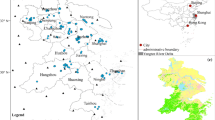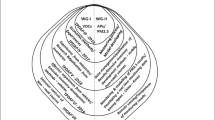Abstract
Nanjing, a megacity in the western Yangtze River Delta of China, has been suffering high PM10 pollution during recent decades. The meteorological conditions that affect the formation of high PM10 pollution in Nanjing remain unknown. In this study, 12-year daily PM10 concentrations and ground-level meteorological conditions from 2001 to 2012 were analyzed. The relationships between PM10 concentrations and meteorological parameters including wind direction, wind speed, temperature, relative humidity, and precipitation were investigated with multiple methods, including occurrence frequency, back trajectory, multiple linear regression (MLR), and artificial neural network (ANN) analysis. The results show that PM10 pollution in Nanjing was severe during 2001–2012. The 12-year mean is 109 μg/m3, which is 56% higher than the grade II annual PM10 standard of China. Declining trends are found for both the annual averages and the episode averages during the most polluted events, with a rate of 3.5 and 4.0 μg/m3 per year, respectively. High PM10 pollution events are more likely to occur on no-precipitation days when wind is from east with speed of 1.0 to 3.0 m/s, temperature is 10 to 20 °C, relative humidity is below 80%, and sea-level pressure is 1015–1025 hPa. The 72- and 24-h back trajectory analysis shows that over half of the air masses on the high PM10 pollution days are from east-south with an average transport distance of around 400 km in 72 h and 200 km in 24 h, respectively. Including the previous day concentration in the MLR models substantially improves model performance for predicting daily PM10, with an increase of the Pearson correlation coefficient from 0.25 to 0.61. The ANN model generally performs better than the MLR models and can be considered as a better method for future PM10 forecasting. However, both models have difficulties accurately predicting very severe pollution events, and more factors should be considered in future studies.








Similar content being viewed by others
References
Atkinson RW, Cohen A, Mehta S, Anderson HR (2012) Systematic review and meta-analysis of epidemiological time-series studies on outdoor air pollution and health in Asia. Air Qual Atmos Hlth 5:383–391
Barmpadimos I, Hueglin C, Keller J, Henne S, Prévôt ASH (2011) influence of meteorology on PM10 trends and variability in Switzerland from 1991 to 2008. Atmos Chem Phys 11:1813–1835. doi:10.5194/acp-11-1813-2011
Bayer-Oglesby L et al (2005) Decline of ambient air pollution levels and improved respiratory health in Swiss children. Environ Health Persp 113:1632–1637. doi:10.1289/ehp.8159
Brunekreef B, Forsberg B (2005) Epidemiological evidence of effects of coarse airborne particles on health. Europesan Respiratory Journal 26:309–318. doi:10.1183/09031936.05.00001805
Cheng Z et al (2013) Long-term trend of haze pollution and impact of particulate matter in the Yangtze River Delta. China Environmental Pollution 182:101–110. doi:10.1016/j.envpol.2013.06.043
Choi Y-S, Ho C-H, Kim J, Gong D-Y, Park RJ (2008) The impact of aerosols on the summer rainfall frequency in China. J Appl Meteorol Clim 47:1802–1813. doi:10.1175/2007jamc1745.1
Davis BL, Guo J (2000) Airborne particulate study in five cities of China. Atmos Environ 34:2703–2711. doi:10.1016/S1352-2310(99)00528-2
Draxler RR (2013) HYSPLIT (HYbrid Single-particle Lagrangian Integrated Trajectory) Model Access via NOAA ARL READY. NOAA Air Resources Laboratory,College Park, MD. http://wwwarlnoaa.gov/HYSPLITphp
Elminir HK (2005) Dependence of urban air pollutants on meteorology. Sci Total Environ 350:225–237. doi:10.1016/j.scitotenv.2005.01.043
Fast JD et al (2007) A meteorological overview of the MILAGRO field campaigns Atmos. Chem Phys 7:2233–2257
Fu Q et al (2008) Mechanism of formation of the heaviest pollution episode ever recorded in the Yangtze River Delta. China Atmos Environ 42:2023–2036. doi:10.1016/j.atmosenv.2007.12.002
Gao JJ et al (2015) The variation of chemical characteristics of PM2.5 and PM10 and formation causes during two haze pollution events in urban Beijing. China Atmos Environ 107:1–8
Griffin DW, Kubilay N, Koçak M, Gray MA, Borden TC, Shinn EA (2007) Airborne desert dust and aeromicrobiology over the Turkish Mediterranean coastline. Atmos Environ 41:4050–4062. doi:10.1016/j.atmosenv.2007.01.023
Gu JX et al (2014) Major chemical compositions, possible sources, and mass closure analysis of PM2.5 in Jinan. China Air Qual Atmos Hlth 7:251–262
Hagan MT, Menhaj MB (1994) Training feedforward networks with the Marquardt algorithm. IEEE Trans Neural Netw 5:989–993. doi:10.1109/72.329697
Hansen LK, Salamon P (1990) Neural network ensembles. IEEE Trans Pattern Anal Mach Intell 12:993–1001. doi:10.1109/34.58871
Harrison RM, Deacon AR, Jones MR, Appleby RS (1997) Sources and processes affecting concentrations of PM10 and PM2.5 particulate matter in Birmingham (U.K.) Atmos Environ 31:4103–4117. doi:10.1016/S1352-2310(97)00296-3
Hooyberghs J, Mensink C, Dumont G, Fierens F, Brasseur O (2005) A neural network forecast for daily average PM concentrations in Belgium. Atmos Environ 39:3279–3289. doi:10.1016/j.atmosenv.2005.01.050
Hou P, Wu SL (2016) Long-term changes in extreme air pollution meteorology and the implications for Air Quality Scientific Reports 6 doi: 10.1038/srep23792
Hu J, Wang Y, Ying Q, Zhang H (2014) Spatial and temporal variability of PM2.5 and PM10 over the North China Plain and the Yangtze River Delta, China. Atmos Environ 95:598–609. doi:10.1016/j.atmosenv.2014.07.019
Hu J, Ying Q, Wang Y, Zhang H (2015b) Characterizing multi-pollutant air pollution in China: comparison of three air quality indices. Environ Int 84:17–25. doi:10.1016/j.envint.2015.06.014
Hu J et al (2015a) Source contributions and regional transport of primary particulate matter in China. Environ Pollut 207:31–42
Huang L, Chen M, Hu J (2016) Twelve-year trends of PM10 and visibility in the Hefei Metropolitan Area of China Advances in Meteorology 2016:9 doi:10.1155/2016/4810796
Huang RJ et al (2014) High secondary aerosol contribution to particulate pollution during haze events in China. Nature 514:218–222. doi:10.1038/nature13774
Kang H, Zhu B, Su J, Wang H, Zhang Q, Wang F (2013) Analysis of a long-lasting haze episode in Nanjing. China Atmos Res 120-121:78–87. doi:10.1016/j.atmosres.2012.08.004
Perrino C, Catrambone M, Pietrodangelo A (2008) Influence of atmospheric stability on the mass concentration and chemical composition of atmospheric particles: a case study in Rome. Italy Environ Int 34:621–628. doi:10.1016/j.envint.2007.12.006
Perrone MP, Cooper LN (1992) When networks disagree: ensemble methods for hybrid neural networks. DTIC Document
Pietruczuk A, Jaroslawski J (2013) Analysis of particulate matter concentrations in Mazovia Region, Central Poland, based on 2007-2010. Data Acta Geophysica 61:445–462. doi:10.2478/s11600-012-0069-x
Pope CA (2000) Review: epidemiological basis for particulate air pollution health standards. Aerosol Sci Technol 32:4–14
Pope CA, Dockery DW (2006) Health effects of fine particulate air pollution: lines that connect. J Air Waste Manage Assoc 56:709–742
Quan J et al (2013) Evolution of planetary boundary layer under different weather conditions, and its impact on aerosol concentrations. Particuology 11:34–40. doi:10.1016/j.partic.2012.04.005
Rolph GD (2013) Real-time Environmental Applications and Display SYstem (READY). NOAA Air Resources Laboratory, College Park, MD. Website http://wwwreadynoaa.gov
Seaton A, Godden D, MacNee W, Donaldson K (1995) Particulate air pollution and acute health effects. Lancet 345:176–178. doi:10.1016/S0140-6736(95)90173-6
Shen G et al (2014) Chemical compositions and reconstructed light extinction coefficients of particulate matter in a mega-city in the western Yangtze River Delta. China Atmos Environ 83:14–20. doi:10.1016/j.atmosenv.2013.10.055
Velders GJM, Matthijsen J (2009) Meteorological variability in NO2 and PM10 concentrations in the Netherlands and its relation with EU limit values. Atmos Environ 43:3858–3866. doi:10.1016/j.atmosenv.2009.05.009
Willers SM, Eriksson C, Gidhagen L, Nilsson ME, Pershagen G, Bellander T (2013) Fine and coarse particulate air pollution in relation to respiratory health in Sweden. Eur Respir J 42:924–934. doi:10.1183/09031936.00088212
Xie SD, Yu T, Zhang YH, Zeng LM, Qi L, Tang XY (2005) Characteristics of PM10, SO2, NO, and O-3 in ambient air during the dust storm period in Beijing. Sci Total Environ 345:153–164. doi:10.1016/j.scitotenv.2004.10.013
Xu J, Yan F, Xie Y, Wang F, Wu J, Fu Q (2015) Impact of meteorological conditions on a nine-day particulate matter pollution event observed in December 2013. Shanghai, China Particuology 20:69–79. doi:10.1016/j.partic.2014.09.001
Yadav S, Praveen OD, Satsangi PG (2015) The effect of climate and meteorological changes on particulate matter in Pune. India Environ Monit Assess 187:1–14. doi:10.1007/s10661-015-4634-z
Zha Y, Gao JAY, Jiang J, Lu H, Huang J (2010) Monitoring of urban air pollution from MODIS aerosol data: effect of meteorological parameters. Tellus B 62:109–116. doi:10.1111/j.1600-0889.2010.00451.x
Zhang HL, Wang YG, Hu JL, Ying Q, Hu XM (2015) Relationships between meteorological parameters and criteria air pollutants in three megacities in China. Environ Res 140:242–254
Zhang H et al (2012) Source apportionment of PM2.5 nitrate and sulfate in China using a source-oriented chemical transport model. Atmos Environ 62:228–242. doi:10.1016/j.atmosenv.2012.08.014
Zhang RH, Li Q, Zhang RN (2013) Meteorological conditions for the persistent severe fog and haze event over eastern China in January 2013. Science China Earth Sciences 57:26–35. doi:10.1007/s11430-013-4774-3
Acknowledgements
This project is partly funded by Jiangsu 1101 project (SBE2014070928), the National Natural Science Foundation of China (No. 41675125), the Natural Science Foundation of Jiangsu Province (BK20150904), Jiangsu Specially Appointed Professor Project (2191071503201), Jiangsu Six Major Talent Peak Project (No. 2015-JNHB-010), and the Priority Academic Program Development of Jiangsu Higher Education Institutions (PAPD), Jiangsu Key Laboratory of Atmospheric Environment Monitoring and Pollution Control of Nanjing University of Information Science and Technology, and Jiangsu Province Innovation Platform for Superiority Subject of Environmental Science and Engineering (No. KHK1201).
Author information
Authors and Affiliations
Corresponding authors
Rights and permissions
About this article
Cite this article
Zu, Y., Huang, L., Hu, J. et al. Investigation of relationships between meteorological conditions and high PM10 pollution in a megacity in the western Yangtze River Delta, China. Air Qual Atmos Health 10, 713–724 (2017). https://doi.org/10.1007/s11869-017-0472-1
Received:
Accepted:
Published:
Issue Date:
DOI: https://doi.org/10.1007/s11869-017-0472-1




